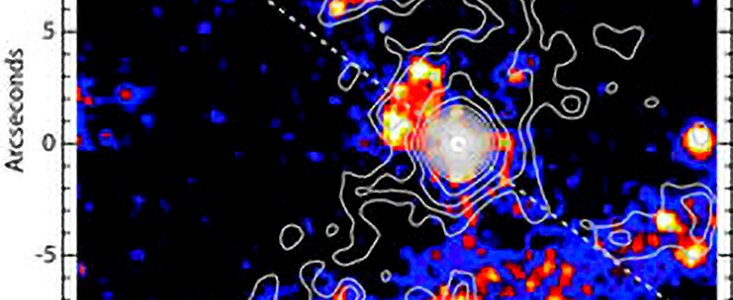Small Warm Doughnut Feeds Theories of Extragalactic Black Holes
8 January 2007
Fundamental to theories describing active galactic nuclei (AGN) is the prediction that a doughnut-shaped ring of material (a torus) surrounds a supermassive black hole in these energetic galactic cores. Yet, understanding an AGN's torus, or indeed seeing one directly, has proved to be extremely frustrating, and has spurred an ongoing debate about their extent and physical properties.
To help settle the debate, an international team of astronomers used a novel approach to peer deeply into the energetic core of the nearby galaxy Centaurus A. Their observations didn't resolve the theoretical torus, but did set stringent constraints on its size and characteristics, indicating that it is likely quite petite and clumpy.
These results were presented today at the 209th meeting of the American Astronomical Society meeting in Seattle, Washington.
The team used observations made at mid-infrared wavelengths with the 8-meter Gemini South telescope in Chile to study warm dust in the nucleus of the galaxy Centaurus A. The results indicate that the theorized doughnut-shaped torus thought to exist at the core of this nearby AGN is beyond the resolution of the largest non-interferometric ground-based telescopes and therefore must be smaller than many models predicted. Team members used an innovative statistical analysis technique and high-resolution images to establish extremely tight constraints on the size of the warm dust in the torus. "We think that this data provides the strongest argument yet in constraining the maximum size of the warm dusty torus in a galaxy of this type," said Principal Investigator and Gemini Observatory astronomer James Radomski.
The research team obtained these observations with the mid-infrared instrument T-ReCS to help settle the ongoing debate about whether the torus and central regions of Centaurus A were ever resolved in previous observations. "If the torus had been resolved in previous observations, that would mean that the extent of the torus is much larger than the latest models predict, and it would have left many of us scratching our heads," said team member Chris Packham of the University of Florida.
Earlier observations made with the 10-meter Keck I telescope by D. Whysong (now at NRAO) and R. Antonucci (University of California, Santa Barbara, with Whysong when this work was done) initially proposed a similar resolution-limited size for the torus in Centaurus A. However, a team using the Magellan Telescope subsequently claimed that the nucleus was indeed resolved and therefore indicative of a much larger structure. The new Gemini South result clearly confirms the earlier Keck result by Whysong and Antonucci.
"This debate definitely shows the difficulty of making these types of observations," said Radomski. "But these observations are critical since we cannot understand the environments around a supermassive galactic black hole without first knowing the extent of its torus."
The new theoretical models of a galactic torus helps to settle what some were calling the "torus size crisis." Without such a model, the observations of Centaurus A would have deepened the size crisis. "These more recent models predict that, far from being a huge and uniform doughnut of gas and dust as once thought, instead the torus orbits the supermassive black hole in clumps. The size constraints placed by the Keck and Gemini data indicate that the clumps are primarily 'bunched up' and must orbit within a few light-years of the black hole," explained team member Nancy Levenson of the University of Kentucky.
Unlike with previous observations, the Gemini team cross-calibrated the mid-infrared data many times against a reference star in order to determine with a high degree of certainty that the nucleus of Centaurus A was unresolved. In addition, because the object was observed for long periods of time, these observations were deep enough to probe the very faint emission beyond the nucleus previously observed only by space based observatories such as the Spitzer Space Telescope. However, Gemini's larger aperture provided higher spatial resolution to reveal details in these regions thought to be due to star formation. It may also trace emission from material flowing into and feeding the black hole at the center of the galaxy.
"By working with a combination of instrument builders, observational and theoretical astronomers, this work has pooled the knowledge of an international group of astronomers in order to gain insights into these objects and extract the maximum amount of knowledge from hard-won telescope time to produce this convincing result," said team member Chris Packham of University of Florida.
Team members (listed by institution) are James T. Radomski, James M. DeBuizer, and Rachel Mason (Gemini Observatory), Christopher Packham, Charles M. Telesco, Manuel Orduna (University of Florida), N.A. Levenson (University of Kentucky), Eric Perlman (University of Maryland), Lerothodi L. Leeuw (Rhodes University, South Africa), and Henry Matthews (Herzberg Institute of Astrophysics, Canada).
Background Information
Centaurus A is one of the nearest examples of an active galactic nucleus (AGN) visible in the sky. This makes it ideally suited for the study of the properties of AGN in general. Its distance from us is thought to be about 11.4 million light-years away. It is an elliptical galaxy that has undergone a merger event with another galaxy as recently as 160 million years ago.
An AGN is a region at the center of a galaxy that emits radiation across the entire spectrum. This radiation is emitted from material that is heated by interactions with a supermassive black hole's intense gravitational field. In the case of Centaurus A, the black hole is about 100 million times the mass of the Sun and shines about 2.5 billion times brighter.
The mid-infrared observations presented here were obtained using the Thermal Region Camera Spectrometer (T-ReCS) which was built at the University of Florida for Gemini.
Contacts
Dr. James Radomski
Gemini Observatory
La Serena, Chile
Tel: +56-51-205-640
Email: jradomski@gemini.edu
Dr. Christopher Packham
University of Florida, Gainsville, FL
Tel: (352) 392-2052
Cell: (352) 514-3333
Email: packham@astro.ufl.edu
Peter Michaud
Gemini Observatory
Hilo HI, USA
Tel: (808) 974-2510
Cell: (808) 937-0845
Email: pmichaud@gemini.edu


